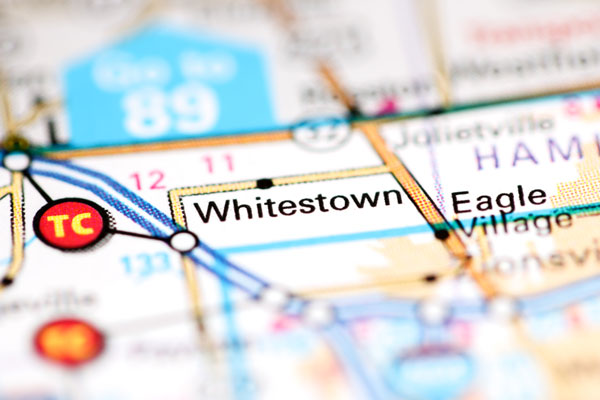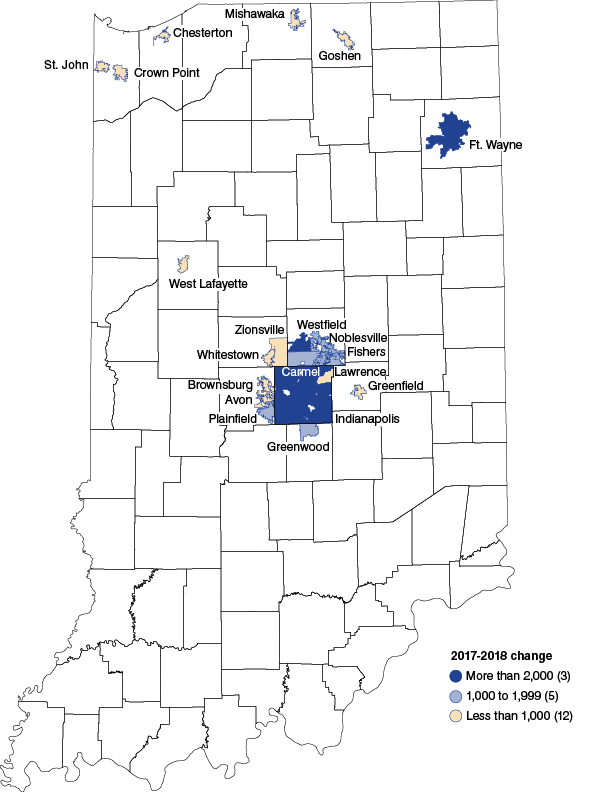Whitestown and Westfield top list of Indiana's fastest-growing communities

This marks the eighth year in a row that Whitestown can claim the title of the state's fastest-growing locale.
For the second consecutive year, Whitestown in Boone County and Westfield in neighboring Hamilton County ranked as Indiana's fastest-growing places among those with a population of at least 5,000 residents.
These two Indianapolis-area suburbs both grew by roughly 5.2 percent in 2018. For Whitestown, this marks the eighth year in a row that it can claim the title of the state's fastest-growing locale. Its population has nearly tripled over this span, from 3,132 in 2010 to 8,627 in 2018.
The following interactive graphic provides details on population change since 2010 for each of Indiana’s 567 incorporated places (see Figure 1)
Figure 1 : Explore Indiana city/town population change
Source: U.S. Census Bureau
Other fast-growing communities include Lake County's St. John (4.9 percent growth in 2018), as well as Avon (4.4 percent) and Plainfield (4.3 percent) in Hendricks County.
In all, 17 of the state's 20 fastest-growing communities are found in either the Indianapolis metro area or the Indiana portion of the Chicago metro area. Outside these areas, Westville in LaPorte County (2.4 percent), Auburn in DeKalb County (1.7 percent) and Goshen in Elkhart County (1.7 percent) set the pace in 2018 (see Figure 2).
Figure 2: Indiana’s fastest-growing cities and towns, 2017 to 2018

Note: Growth rate rankings limited to cities and towns with at least 5,000 residents
Source: U.S. Census Bureau
In terms of numeric change, Indiana's two largest cities posted the state's most sizeable gains.
Indianapolis added 5,235 residents in 2018, while Fort Wayne's population grew by 2,178 people. A trio of Hamilton County communities—Westfield (2,046 increase), Fishers (1,679) and Carmel (1,521)—round out the state's top five largest gains (see Figure 3).
Figure 3: Cities with largest population growth, 2017 to 2018

Source: U.S. Census Bureau
Indiana’s largest cities
With a population of 867,125 residents, Indianapolis was the nation's 17th-largest city in 2018, ranking just behind Charlotte, North Carolina (872,498), and ahead of Seattle, Washington (744,955). Fort Wayne's population reached 267,633 in 2018 and ranks as the 77th-largest city in the United States.
Evansville (population 117,963) and South Bend (101,860) are the only other Indiana cities with more than 100,000 residents. Both of these cities saw a slight dip in population in 2018, with Evansville losing 325 residents last year and South Bend down 108 people.
Carmel remained the state's fifth-largest city, as the addition of 1,521 new residents in 2018 brought its population to 93,510. Fishers ranked just behind its neighbor, as an uptick of 1,679 residents raised its population to 93,362.
As Table 1 shows, the remainder of Indiana's 10 largest cities are Bloomington (84,981), Hammond (75,795), Gary (75,282) and Lafayette (72,168).
Table 1: Indiana’s 10 largest cities, 2018
| City | Total population, 2018 | Population change, 2017 to 2018 | |
|---|---|---|---|
| Number | Percent | ||
| Indianapolis | 867,125 | 5,235 | 0.6% |
| Fort Wayne | 267,633 | 2,178 | 0.8% |
| Evansville | 117,963 | -325 | -0.3% |
| South Bend | 101,860 | -108 | -0.1% |
| Carmel | 93,510 | 1,521 | 1.7% |
| Fishers | 93,362 | 1,679 | 1.8% |
| Bloomington | 84,981 | 85 | 0.1% |
| Hammond | 75,795 | -623 | -0.8% |
| Gary | 75,282 | -599 | -0.8% |
| Lafayette | 72,168 | -106 | -0.1% |
Source: U.S. Census Bureau
Twelve of Indiana's 20 largest cities posted a population gain in 2018. Among the cities that lost population, Hammond had the largest decline, losing an estimated 623 residents. Other cities with relatively large drops include Gary (decline of 599 residents) and Muncie (down 422).
Town and country
Looking at differences between urban and rural communities, the data show that most Hoosiers live in cities or towns. Nearly 34 percent of the state's population lived in a city with a population of at least 50,000 in 2018. Meanwhile, 20 percent of Hoosiers lived in an incorporated place of between 10,000 and 50,000 residents, while another 12 percent lived in a city or town with fewer than 10,000 residents (see Table 2).
Table 2: Indiana population by type of community, 2018
| Community type | Total Population | Percent of Indiana population | Percent change, 2017 to 2018 |
|---|---|---|---|
| City/town, population 50,000+ | 2,266,145 | 33.9% | 0.5% |
| City/town, population 10,000-49,999 | 1,368,380 | 20.4% | 0.8% |
| City/town, population < 10,000 | 829,701 | 12.4% | 0.3% |
| Unincorporated areas | 2,227,652 | 33.3% | 0.3% |
Source: U.S. Census Bureau
In all, two-thirds of Indiana's 6.69 million residents in 2018 lived in incorporated places, while the remaining 2.2 million Hoosier residents lived in unincorporated areas of the state. Indiana's cities and towns as a group accounted for 79 percent of the state's total population growth in 2018.
For more information about these estimates, visit STATS Indiana at http://www.stats.indiana.edu/topic/population.asp.
